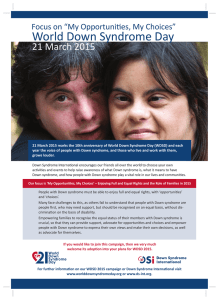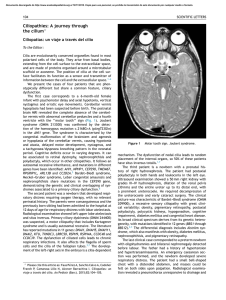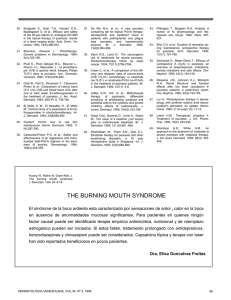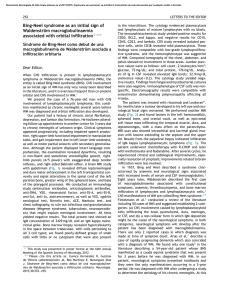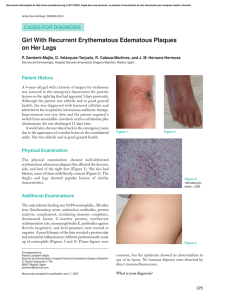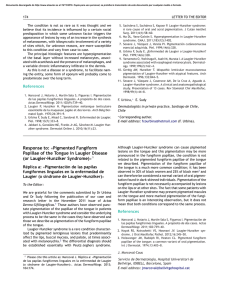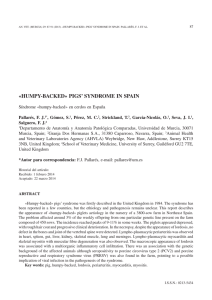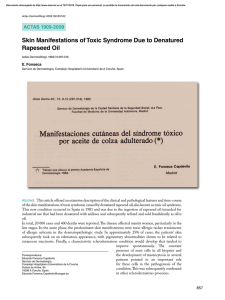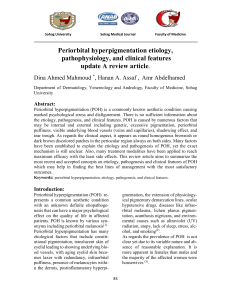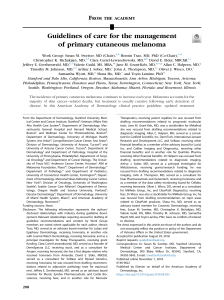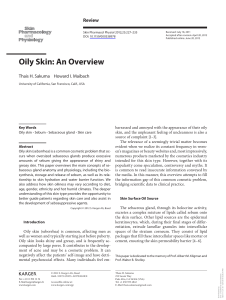Nicolau syndrome after administration of glatiramer acetate
Anuncio
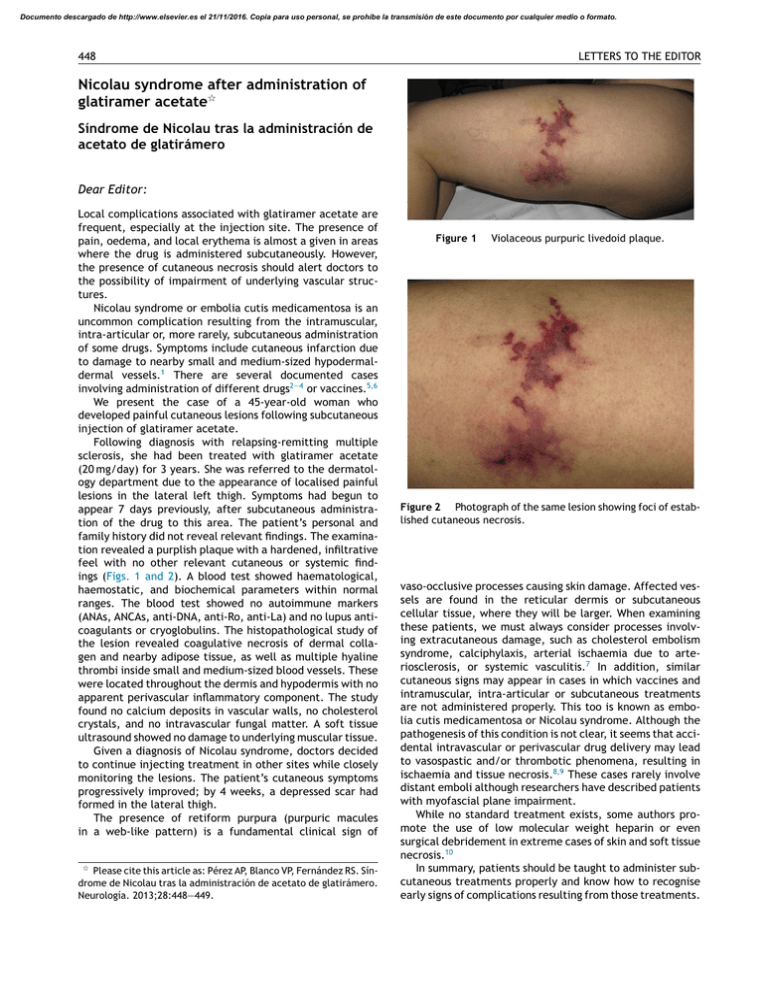
Documento descargado de http://www.elsevier.es el 21/11/2016. Copia para uso personal, se prohíbe la transmisión de este documento por cualquier medio o formato. 448 LETTERS TO THE EDITOR Nicolau syndrome after administration of glatiramer acetate夽 Síndrome de Nicolau tras la administración de acetato de glatirámero Dear Editor: Local complications associated with glatiramer acetate are frequent, especially at the injection site. The presence of pain, oedema, and local erythema is almost a given in areas where the drug is administered subcutaneously. However, the presence of cutaneous necrosis should alert doctors to the possibility of impairment of underlying vascular structures. Nicolau syndrome or embolia cutis medicamentosa is an uncommon complication resulting from the intramuscular, intra-articular or, more rarely, subcutaneous administration of some drugs. Symptoms include cutaneous infarction due to damage to nearby small and medium-sized hypodermaldermal vessels.1 There are several documented cases involving administration of different drugs2—4 or vaccines.5,6 We present the case of a 45-year-old woman who developed painful cutaneous lesions following subcutaneous injection of glatiramer acetate. Following diagnosis with relapsing-remitting multiple sclerosis, she had been treated with glatiramer acetate (20 mg/day) for 3 years. She was referred to the dermatology department due to the appearance of localised painful lesions in the lateral left thigh. Symptoms had begun to appear 7 days previously, after subcutaneous administration of the drug to this area. The patient’s personal and family history did not reveal relevant findings. The examination revealed a purplish plaque with a hardened, infiltrative feel with no other relevant cutaneous or systemic findings (Figs. 1 and 2). A blood test showed haematological, haemostatic, and biochemical parameters within normal ranges. The blood test showed no autoimmune markers (ANAs, ANCAs, anti-DNA, anti-Ro, anti-La) and no lupus anticoagulants or cryoglobulins. The histopathological study of the lesion revealed coagulative necrosis of dermal collagen and nearby adipose tissue, as well as multiple hyaline thrombi inside small and medium-sized blood vessels. These were located throughout the dermis and hypodermis with no apparent perivascular inflammatory component. The study found no calcium deposits in vascular walls, no cholesterol crystals, and no intravascular fungal matter. A soft tissue ultrasound showed no damage to underlying muscular tissue. Given a diagnosis of Nicolau syndrome, doctors decided to continue injecting treatment in other sites while closely monitoring the lesions. The patient’s cutaneous symptoms progressively improved; by 4 weeks, a depressed scar had formed in the lateral thigh. The presence of retiform purpura (purpuric macules in a web-like pattern) is a fundamental clinical sign of 夽 Please cite this article as: Pérez AP, Blanco VP, Fernández RS. Síndrome de Nicolau tras la administración de acetato de glatirámero. Neurología. 2013;28:448—449. Figure 1 Violaceous purpuric livedoid plaque. Figure 2 Photograph of the same lesion showing foci of established cutaneous necrosis. vaso-occlusive processes causing skin damage. Affected vessels are found in the reticular dermis or subcutaneous cellular tissue, where they will be larger. When examining these patients, we must always consider processes involving extracutaneous damage, such as cholesterol embolism syndrome, calciphylaxis, arterial ischaemia due to arteriosclerosis, or systemic vasculitis.7 In addition, similar cutaneous signs may appear in cases in which vaccines and intramuscular, intra-articular or subcutaneous treatments are not administered properly. This too is known as embolia cutis medicamentosa or Nicolau syndrome. Although the pathogenesis of this condition is not clear, it seems that accidental intravascular or perivascular drug delivery may lead to vasospastic and/or thrombotic phenomena, resulting in ischaemia and tissue necrosis.8,9 These cases rarely involve distant emboli although researchers have described patients with myofascial plane impairment. While no standard treatment exists, some authors promote the use of low molecular weight heparin or even surgical debridement in extreme cases of skin and soft tissue necrosis.10 In summary, patients should be taught to administer subcutaneous treatments properly and know how to recognise early signs of complications resulting from those treatments. Documento descargado de http://www.elsevier.es el 21/11/2016. Copia para uso personal, se prohíbe la transmisión de este documento por cualquier medio o formato. LETTERS TO THE EDITOR References 1. Koller S, Kränke B. Nicolau syndrome following subcutaneous glatiramer-acetate injection. J Am Acad Dermatol. 2011;64:16—7. 2. Kim KK. Nicolau syndrome in patient following diclofenac administration: a case report. Ann Dermatol. 2011;23: 501—3. 3. Gaudez C, Regnier S, Aractingi S, Heinzlef O. Livedolike dermatitis (Nicolau’s syndrome) after injection of Copolymer-1 (Glatiramer acetate). Rev Neurol (Paris). 2003;159:571—3. 4. Corazza M, Capozzi O, Virgilit A. Five cases of livedo-like dermatitis (Nicolau’s syndrome) due to bismuth salts and various other non-steroidal anti-inflammatory drugs. J Eur Acad Dermatol Venereol. 2001;15:585—8. 5. Kienast AK, Mentze D, Hoeger PH. Nicolau’s syndrome induced by intramuscular vaccinations in children: report of seven patients and review of the literature. Clin Exp Dermatol. 2008;33:555—8. 6. Nagore E, Torrelo A, González-Mediero I, Zambrano A. Livedoid skin necrosis (Nicolau syndrome) due to triple vaccine (DTP) injection. Br J Dermatol. 1997;137:1030—1. Potomania and osmotic imbalance: Permanent cortical visual impairment due to extrapontine myelinolysis夽 Potomanía y desequilibrio osmótico: Ceguera cortical definitiva por mielinólisis extrapontina Dear Editor: Potomania or psychogenic polydipsia is characterised by excessive drinking of liquids, such as water (polydipsia) or alcohol (dipsomania). Excessive drinking may lead to hyponatraemia (HNa) even in patients presenting no organic, metabolic, or toxic diseases.1,2 Central pontine myelinolysis (PM) and extrapontine myelinolysis (EPM) have numerous manifestations and affect different areas (generally symmetrical areas). Myelinolysis is mainly caused by hyponatraemia and the means used to correct it; to a lesser extent, it may be caused by association with hypokalaemia. We present the case of a woman aged 72 who was admitted to the hospital in a coma 3 hours after its onset. Coma was preceded by disorientation and progressive stupor developing in the preceding 6 hours. The patient presented decreased muscle tone in all limbs, deep tendon areflexia, lack of Babinski sign, and bilateral plantar reflex due to pain. The oculocephalic, corneal, and photomotor reflexes were present. The Glasgow coma scale score was 6/15. Studies showed no renal, cardiac, or hormonal disorders. The 夽 Please cite this article as: Domínguez RO, Laguarde N, Pinkala E, González SE. Potomanía y desequilibrio osmótico: Ceguera cortical definitiva por mielinólisis extrapontina. Neurología. 2013;28:449—450. 449 7. Wysong A, Venkatesan P. An approach to the patient with retiform purpura. Dermatol Ther. 2011;24:151—72. 8. Martínez-Morán C, Espinosa-Lara P, Nájera L, Romero-Maté A, Córdoba S, Hernández-Núñez A, et al. Embolia cutis medicamentosa (síndrome de Nicolau) tras inyección de acetato de glatirámero. Actas Dermosifiliogr. 2011;102:742—4. 9. Ruffieux P, Salomon D, Saurat JH. Livedo-like dermatitis (Nicolau’s syndrome): a review of three cases. Dermatology. 1996;193:368—71. 10. Marangi GF, Gigliofiorito P, Toto V, Langella M, Pallara T, Persichetti P. Three cases of embolia cutis medicamentosa (Nicolau’s syndrome). J Dermatol. 2010;37:488—92. A. Pulido Pérez a,∗ , V. Parra Blanco b , R. Suárez Fernández a a Servicio de Dermatología, Hospital General Universitario Gregorio Marañón, Madrid, Spain b Servicio de Anatomía Patológica, Hospital General Universitario Gregorio Marañón, Madrid, Spain ∗ Corresponding author. E-mail address: ana.pulido@madrimasd.net (A. Pulido Pérez). patient had a history of non-alcoholic potomania in the preceding 6 months (water intake of 4 to 6 litres daily). She was in psychotherapy and undergoing treatment with quetiapine (50 mg/day). This treatment was beneficial for 5 months, after which potomania appeared again. Blood tests revealed hyponatraemia of 111 mM/L and hypokalaemia of 2.2 mM/L. The rest of the results were anodyne. The ECG showed sinus rhythm, a heart rate of 85 beats per minute, ST segment deviation, and flat T wave. The computed tomography (CT) performed in the first 12 hours yielded normal results. Natraemia was corrected at a rate of 9 mM/L/day; kalaemia was corrected by administering 5 mM/h of potassium chloride intravenously. The patient awoke 48 hours later with a confusional state, flexor withdrawal reflex in all 4 limbs, and purposeless hand movements. The Glasgow coma scale score was 12/15. At this time, natraemia was 127 mM/L and kalaemia, 3.7 mM/L. Doctors suspected bilateral vision loss since stimulating visual fields with rapid, nearby movements elicited no blink reflex. The brain MRI carried out on the third day of hospitalisation (Fig. 1) showed occipital lesions. There were no changes in the pons or the cerebral/cerebellar hemispheres. Blood test showed normal results on the 10th day after admission. Another brain MRI showed similar changes and the angiography of the neck vessels and intracranial arteries yielded normal results. In the fourth week of hospitalisation, the patient presented no cognitive decline, but cortical blindness had not abated. She was lucid and aware of her visual impairment. There are 2 main causes of hyponatraemia: net increase in water (total sodium remains normal), and sodium loss. Although the mechanisms often coexist, one is frequently predominant. In our case, psychogenic polydipsia triggered dilutional hyponatraemia; researchers found no primary diseases inducing potomania or hyponatraemia. PM is suspected when the patient presents severe manifestations (disorientation, stupor and coma, tetraparesis) or a history of malnutrition, alcoholism, or polydipsia.
